PSYC 1160 Literature Review: Early BPD Assessment and Management
VerifiedAdded on 2022/08/12
|8
|1885
|25
Literature Review
AI Summary
This literature review explores the effectiveness of early assessment and screening for Borderline Personality Disorder (BPD). The paper examines various psychological theories of personality, the assessment methods used (including pencil-and-paper tests and projective tests), and the specific application of these methods to BPD. It investigates the research question of whether early assessment leads to better management of BPD cases. The review synthesizes findings from several studies, including those by Wertz et al. (2019), Beck (2019), Conway et al. (2019), Barazandeh et al. (2016), and Winsper et al. (2016). These studies highlight the importance of early intervention and assessment in predicting better outcomes, particularly in relation to cognitive rigidity, emotional liability, and maladaptive behaviors. The review concludes that early assessment is crucial for effective BPD management, although it notes gaps in the literature regarding specific trait identification and the prioritization of assessment methods. The review emphasizes the need for further research to refine and optimize early BPD assessment strategies. The findings underscore the significance of early clinical assessments in understanding BPD in subjects and the early identification of childhood maladaptive behaviours.
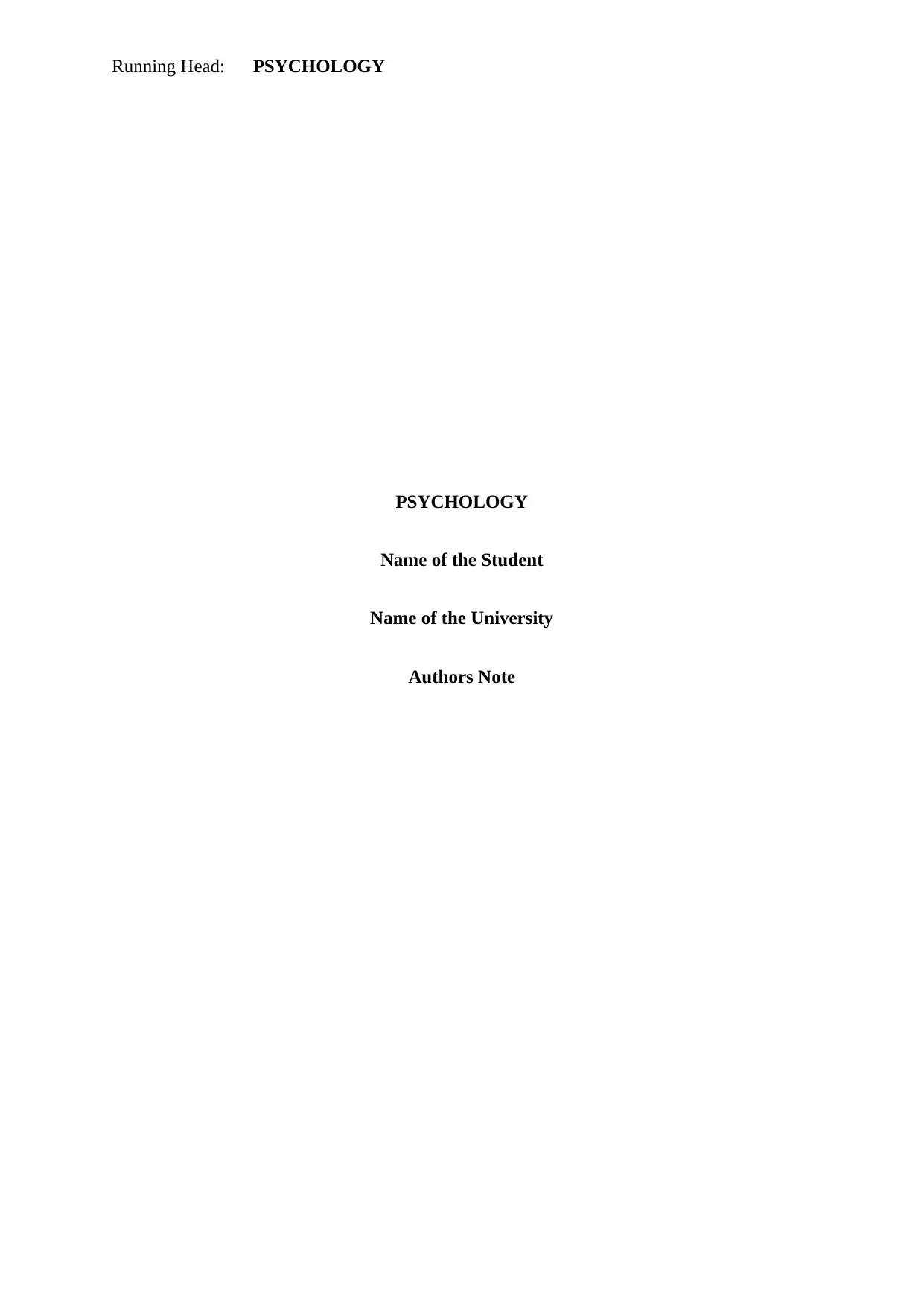
Running Head: PSYCHOLOGY
PSYCHOLOGY
Name of the Student
Name of the University
Authors Note
PSYCHOLOGY
Name of the Student
Name of the University
Authors Note
Paraphrase This Document
Need a fresh take? Get an instant paraphrase of this document with our AI Paraphraser
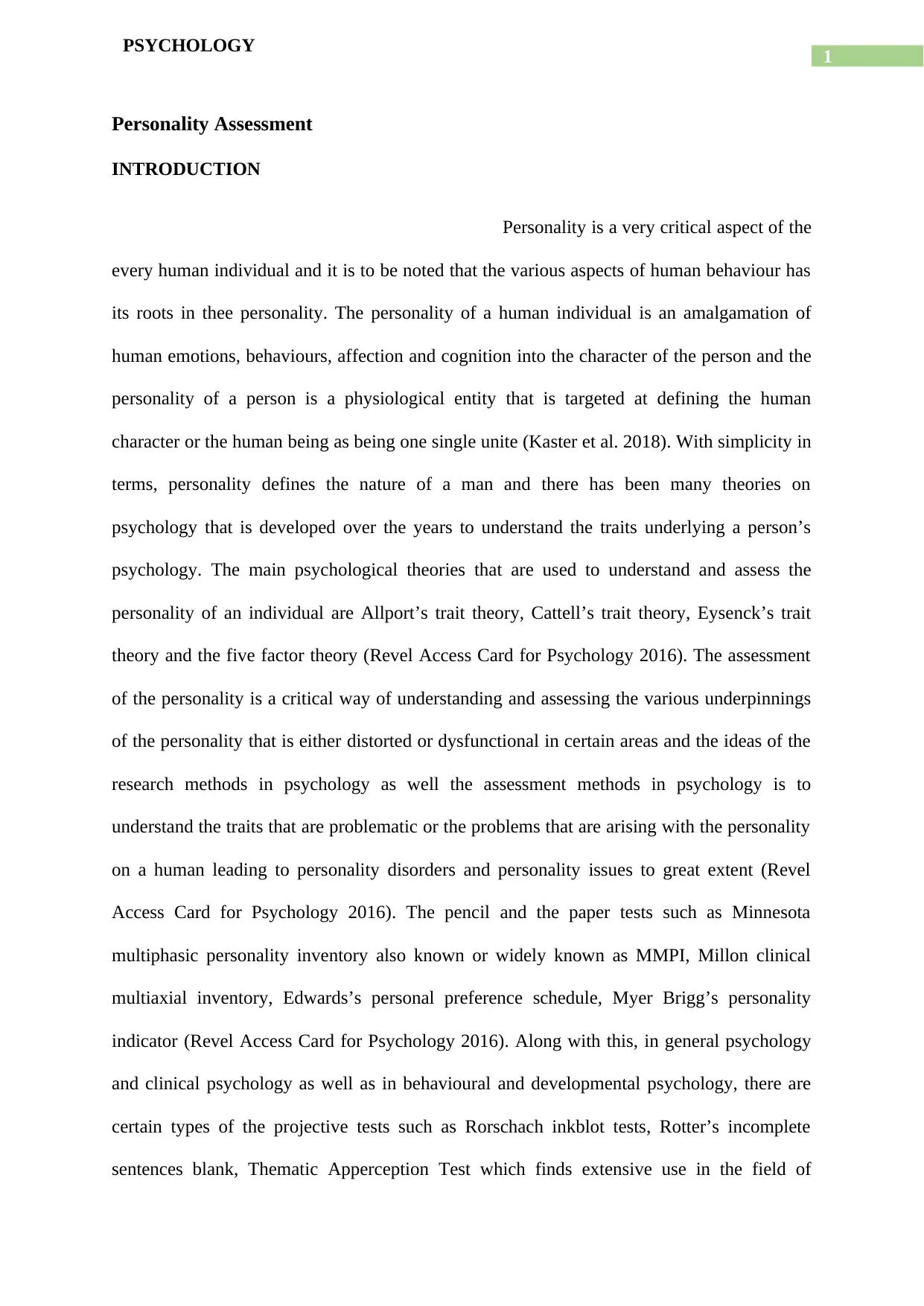
1
PSYCHOLOGY
Personality Assessment
INTRODUCTION
Personality is a very critical aspect of the
every human individual and it is to be noted that the various aspects of human behaviour has
its roots in thee personality. The personality of a human individual is an amalgamation of
human emotions, behaviours, affection and cognition into the character of the person and the
personality of a person is a physiological entity that is targeted at defining the human
character or the human being as being one single unite (Kaster et al. 2018). With simplicity in
terms, personality defines the nature of a man and there has been many theories on
psychology that is developed over the years to understand the traits underlying a person’s
psychology. The main psychological theories that are used to understand and assess the
personality of an individual are Allport’s trait theory, Cattell’s trait theory, Eysenck’s trait
theory and the five factor theory (Revel Access Card for Psychology 2016). The assessment
of the personality is a critical way of understanding and assessing the various underpinnings
of the personality that is either distorted or dysfunctional in certain areas and the ideas of the
research methods in psychology as well the assessment methods in psychology is to
understand the traits that are problematic or the problems that are arising with the personality
on a human leading to personality disorders and personality issues to great extent (Revel
Access Card for Psychology 2016). The pencil and the paper tests such as Minnesota
multiphasic personality inventory also known or widely known as MMPI, Millon clinical
multiaxial inventory, Edwards’s personal preference schedule, Myer Brigg’s personality
indicator (Revel Access Card for Psychology 2016). Along with this, in general psychology
and clinical psychology as well as in behavioural and developmental psychology, there are
certain types of the projective tests such as Rorschach inkblot tests, Rotter’s incomplete
sentences blank, Thematic Apperception Test which finds extensive use in the field of
PSYCHOLOGY
Personality Assessment
INTRODUCTION
Personality is a very critical aspect of the
every human individual and it is to be noted that the various aspects of human behaviour has
its roots in thee personality. The personality of a human individual is an amalgamation of
human emotions, behaviours, affection and cognition into the character of the person and the
personality of a person is a physiological entity that is targeted at defining the human
character or the human being as being one single unite (Kaster et al. 2018). With simplicity in
terms, personality defines the nature of a man and there has been many theories on
psychology that is developed over the years to understand the traits underlying a person’s
psychology. The main psychological theories that are used to understand and assess the
personality of an individual are Allport’s trait theory, Cattell’s trait theory, Eysenck’s trait
theory and the five factor theory (Revel Access Card for Psychology 2016). The assessment
of the personality is a critical way of understanding and assessing the various underpinnings
of the personality that is either distorted or dysfunctional in certain areas and the ideas of the
research methods in psychology as well the assessment methods in psychology is to
understand the traits that are problematic or the problems that are arising with the personality
on a human leading to personality disorders and personality issues to great extent (Revel
Access Card for Psychology 2016). The pencil and the paper tests such as Minnesota
multiphasic personality inventory also known or widely known as MMPI, Millon clinical
multiaxial inventory, Edwards’s personal preference schedule, Myer Brigg’s personality
indicator (Revel Access Card for Psychology 2016). Along with this, in general psychology
and clinical psychology as well as in behavioural and developmental psychology, there are
certain types of the projective tests such as Rorschach inkblot tests, Rotter’s incomplete
sentences blank, Thematic Apperception Test which finds extensive use in the field of
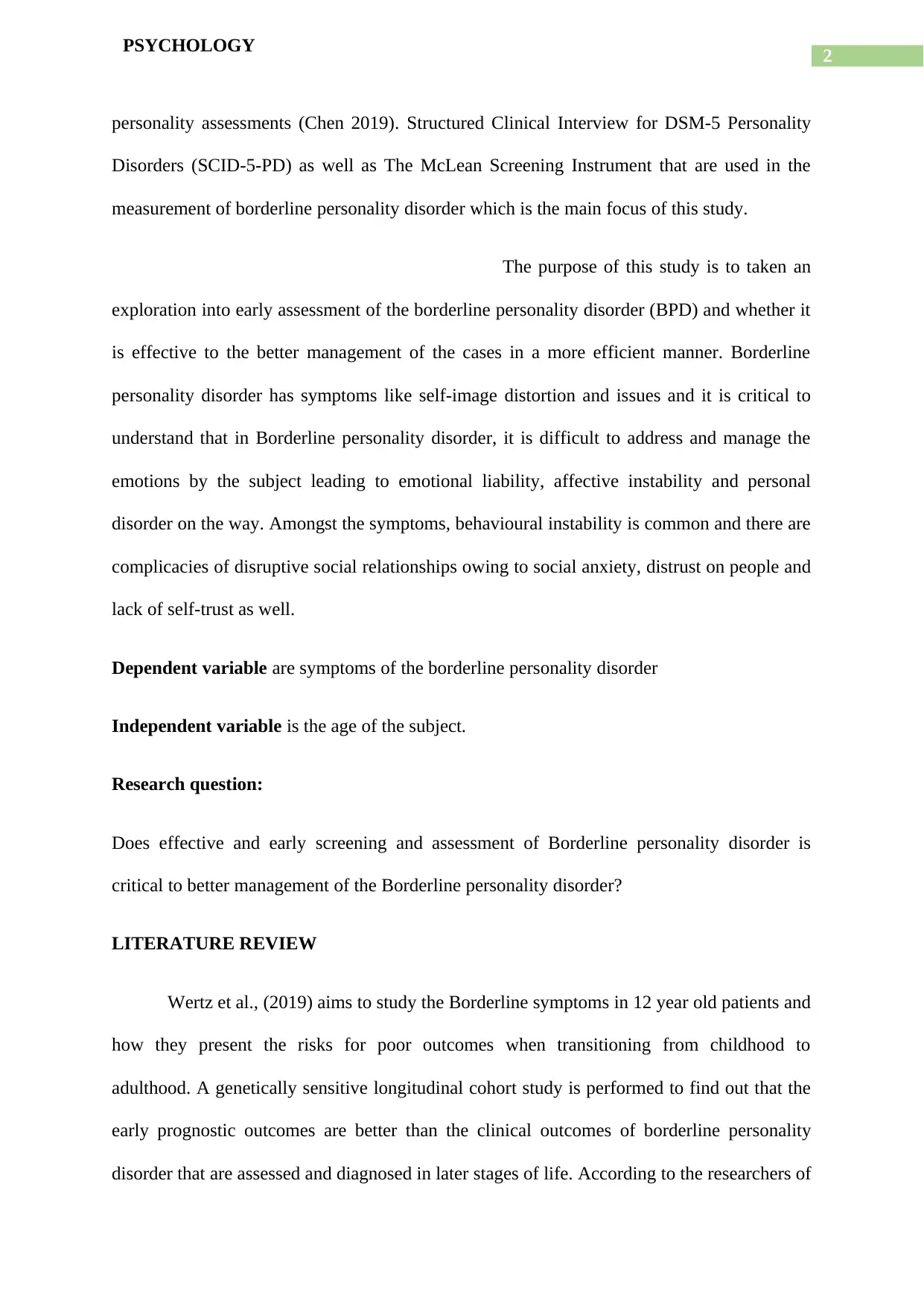
2
PSYCHOLOGY
personality assessments (Chen 2019). Structured Clinical Interview for DSM-5 Personality
Disorders (SCID-5-PD) as well as The McLean Screening Instrument that are used in the
measurement of borderline personality disorder which is the main focus of this study.
The purpose of this study is to taken an
exploration into early assessment of the borderline personality disorder (BPD) and whether it
is effective to the better management of the cases in a more efficient manner. Borderline
personality disorder has symptoms like self-image distortion and issues and it is critical to
understand that in Borderline personality disorder, it is difficult to address and manage the
emotions by the subject leading to emotional liability, affective instability and personal
disorder on the way. Amongst the symptoms, behavioural instability is common and there are
complicacies of disruptive social relationships owing to social anxiety, distrust on people and
lack of self-trust as well.
Dependent variable are symptoms of the borderline personality disorder
Independent variable is the age of the subject.
Research question:
Does effective and early screening and assessment of Borderline personality disorder is
critical to better management of the Borderline personality disorder?
LITERATURE REVIEW
Wertz et al., (2019) aims to study the Borderline symptoms in 12 year old patients and
how they present the risks for poor outcomes when transitioning from childhood to
adulthood. A genetically sensitive longitudinal cohort study is performed to find out that the
early prognostic outcomes are better than the clinical outcomes of borderline personality
disorder that are assessed and diagnosed in later stages of life. According to the researchers of
PSYCHOLOGY
personality assessments (Chen 2019). Structured Clinical Interview for DSM-5 Personality
Disorders (SCID-5-PD) as well as The McLean Screening Instrument that are used in the
measurement of borderline personality disorder which is the main focus of this study.
The purpose of this study is to taken an
exploration into early assessment of the borderline personality disorder (BPD) and whether it
is effective to the better management of the cases in a more efficient manner. Borderline
personality disorder has symptoms like self-image distortion and issues and it is critical to
understand that in Borderline personality disorder, it is difficult to address and manage the
emotions by the subject leading to emotional liability, affective instability and personal
disorder on the way. Amongst the symptoms, behavioural instability is common and there are
complicacies of disruptive social relationships owing to social anxiety, distrust on people and
lack of self-trust as well.
Dependent variable are symptoms of the borderline personality disorder
Independent variable is the age of the subject.
Research question:
Does effective and early screening and assessment of Borderline personality disorder is
critical to better management of the Borderline personality disorder?
LITERATURE REVIEW
Wertz et al., (2019) aims to study the Borderline symptoms in 12 year old patients and
how they present the risks for poor outcomes when transitioning from childhood to
adulthood. A genetically sensitive longitudinal cohort study is performed to find out that the
early prognostic outcomes are better than the clinical outcomes of borderline personality
disorder that are assessed and diagnosed in later stages of life. According to the researchers of
⊘ This is a preview!⊘
Do you want full access?
Subscribe today to unlock all pages.

Trusted by 1+ million students worldwide
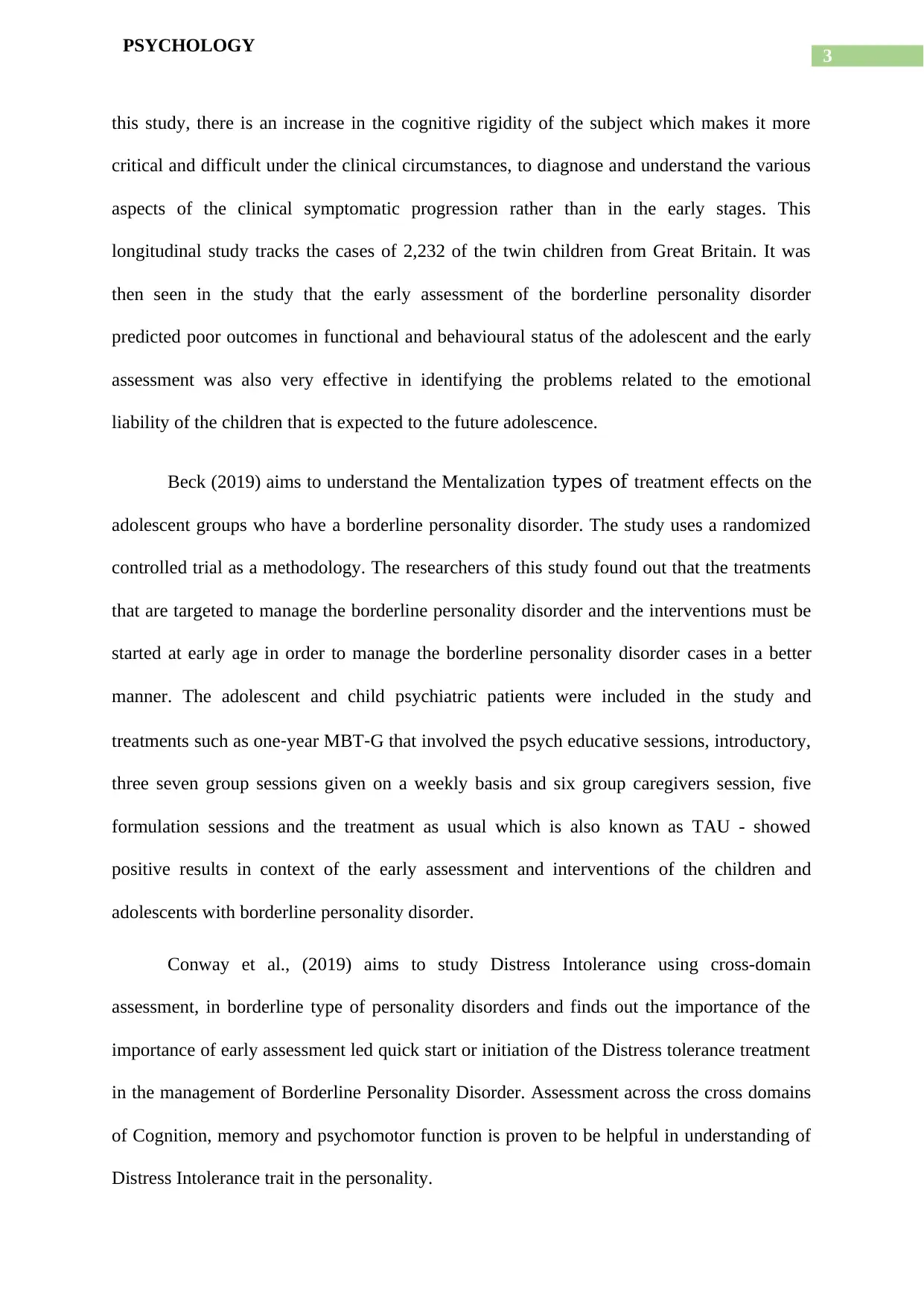
3
PSYCHOLOGY
this study, there is an increase in the cognitive rigidity of the subject which makes it more
critical and difficult under the clinical circumstances, to diagnose and understand the various
aspects of the clinical symptomatic progression rather than in the early stages. This
longitudinal study tracks the cases of 2,232 of the twin children from Great Britain. It was
then seen in the study that the early assessment of the borderline personality disorder
predicted poor outcomes in functional and behavioural status of the adolescent and the early
assessment was also very effective in identifying the problems related to the emotional
liability of the children that is expected to the future adolescence.
Beck (2019) aims to understand the Mentalization types of treatment effects on the
adolescent groups who have a borderline personality disorder. The study uses a randomized
controlled trial as a methodology. The researchers of this study found out that the treatments
that are targeted to manage the borderline personality disorder and the interventions must be
started at early age in order to manage the borderline personality disorder cases in a better
manner. The adolescent and child psychiatric patients were included in the study and
treatments such as one‐year MBT‐G that involved the psych educative sessions, introductory,
three seven group sessions given on a weekly basis and six group caregivers session, five
formulation sessions and the treatment as usual which is also known as TAU - showed
positive results in context of the early assessment and interventions of the children and
adolescents with borderline personality disorder.
Conway et al., (2019) aims to study Distress Intolerance using cross-domain
assessment, in borderline type of personality disorders and finds out the importance of the
importance of early assessment led quick start or initiation of the Distress tolerance treatment
in the management of Borderline Personality Disorder. Assessment across the cross domains
of Cognition, memory and psychomotor function is proven to be helpful in understanding of
Distress Intolerance trait in the personality.
PSYCHOLOGY
this study, there is an increase in the cognitive rigidity of the subject which makes it more
critical and difficult under the clinical circumstances, to diagnose and understand the various
aspects of the clinical symptomatic progression rather than in the early stages. This
longitudinal study tracks the cases of 2,232 of the twin children from Great Britain. It was
then seen in the study that the early assessment of the borderline personality disorder
predicted poor outcomes in functional and behavioural status of the adolescent and the early
assessment was also very effective in identifying the problems related to the emotional
liability of the children that is expected to the future adolescence.
Beck (2019) aims to understand the Mentalization types of treatment effects on the
adolescent groups who have a borderline personality disorder. The study uses a randomized
controlled trial as a methodology. The researchers of this study found out that the treatments
that are targeted to manage the borderline personality disorder and the interventions must be
started at early age in order to manage the borderline personality disorder cases in a better
manner. The adolescent and child psychiatric patients were included in the study and
treatments such as one‐year MBT‐G that involved the psych educative sessions, introductory,
three seven group sessions given on a weekly basis and six group caregivers session, five
formulation sessions and the treatment as usual which is also known as TAU - showed
positive results in context of the early assessment and interventions of the children and
adolescents with borderline personality disorder.
Conway et al., (2019) aims to study Distress Intolerance using cross-domain
assessment, in borderline type of personality disorders and finds out the importance of the
importance of early assessment led quick start or initiation of the Distress tolerance treatment
in the management of Borderline Personality Disorder. Assessment across the cross domains
of Cognition, memory and psychomotor function is proven to be helpful in understanding of
Distress Intolerance trait in the personality.
Paraphrase This Document
Need a fresh take? Get an instant paraphrase of this document with our AI Paraphraser
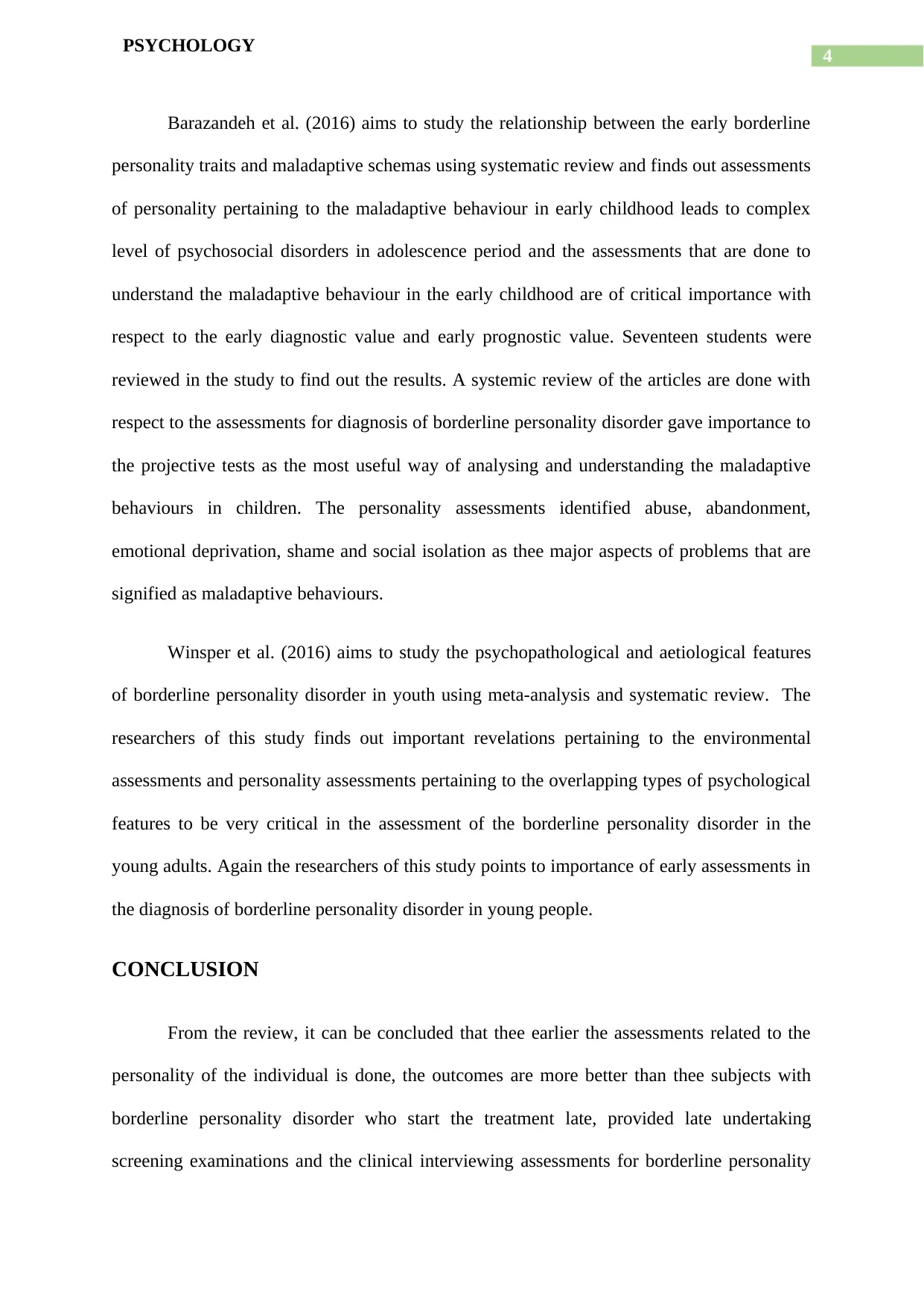
4
PSYCHOLOGY
Barazandeh et al. (2016) aims to study the relationship between the early borderline
personality traits and maladaptive schemas using systematic review and finds out assessments
of personality pertaining to the maladaptive behaviour in early childhood leads to complex
level of psychosocial disorders in adolescence period and the assessments that are done to
understand the maladaptive behaviour in the early childhood are of critical importance with
respect to the early diagnostic value and early prognostic value. Seventeen students were
reviewed in the study to find out the results. A systemic review of the articles are done with
respect to the assessments for diagnosis of borderline personality disorder gave importance to
the projective tests as the most useful way of analysing and understanding the maladaptive
behaviours in children. The personality assessments identified abuse, abandonment,
emotional deprivation, shame and social isolation as thee major aspects of problems that are
signified as maladaptive behaviours.
Winsper et al. (2016) aims to study the psychopathological and aetiological features
of borderline personality disorder in youth using meta-analysis and systematic review. The
researchers of this study finds out important revelations pertaining to the environmental
assessments and personality assessments pertaining to the overlapping types of psychological
features to be very critical in the assessment of the borderline personality disorder in the
young adults. Again the researchers of this study points to importance of early assessments in
the diagnosis of borderline personality disorder in young people.
CONCLUSION
From the review, it can be concluded that thee earlier the assessments related to the
personality of the individual is done, the outcomes are more better than thee subjects with
borderline personality disorder who start the treatment late, provided late undertaking
screening examinations and the clinical interviewing assessments for borderline personality
PSYCHOLOGY
Barazandeh et al. (2016) aims to study the relationship between the early borderline
personality traits and maladaptive schemas using systematic review and finds out assessments
of personality pertaining to the maladaptive behaviour in early childhood leads to complex
level of psychosocial disorders in adolescence period and the assessments that are done to
understand the maladaptive behaviour in the early childhood are of critical importance with
respect to the early diagnostic value and early prognostic value. Seventeen students were
reviewed in the study to find out the results. A systemic review of the articles are done with
respect to the assessments for diagnosis of borderline personality disorder gave importance to
the projective tests as the most useful way of analysing and understanding the maladaptive
behaviours in children. The personality assessments identified abuse, abandonment,
emotional deprivation, shame and social isolation as thee major aspects of problems that are
signified as maladaptive behaviours.
Winsper et al. (2016) aims to study the psychopathological and aetiological features
of borderline personality disorder in youth using meta-analysis and systematic review. The
researchers of this study finds out important revelations pertaining to the environmental
assessments and personality assessments pertaining to the overlapping types of psychological
features to be very critical in the assessment of the borderline personality disorder in the
young adults. Again the researchers of this study points to importance of early assessments in
the diagnosis of borderline personality disorder in young people.
CONCLUSION
From the review, it can be concluded that thee earlier the assessments related to the
personality of the individual is done, the outcomes are more better than thee subjects with
borderline personality disorder who start the treatment late, provided late undertaking
screening examinations and the clinical interviewing assessments for borderline personality

5
PSYCHOLOGY
disorder. The literature did analyse the importance of early clinical assessments being used to
understand borderline personality disorder in the subjects. Though the literature identified
assessment methods in pertinence to the early identification of childhood maladaptive
behaviours but there was a gap left due to the fact that the literature did not identify the
priority personality assessment methods in diagnosis of borderline personality disorder. The
specific trait identification in relation to borderline personality disorders were done in very
few studies. The groups, target populations, methods and the sample size in most of the
studies were consistent but all the articles explored the problem in their own ways.
PSYCHOLOGY
disorder. The literature did analyse the importance of early clinical assessments being used to
understand borderline personality disorder in the subjects. Though the literature identified
assessment methods in pertinence to the early identification of childhood maladaptive
behaviours but there was a gap left due to the fact that the literature did not identify the
priority personality assessment methods in diagnosis of borderline personality disorder. The
specific trait identification in relation to borderline personality disorders were done in very
few studies. The groups, target populations, methods and the sample size in most of the
studies were consistent but all the articles explored the problem in their own ways.
⊘ This is a preview!⊘
Do you want full access?
Subscribe today to unlock all pages.

Trusted by 1+ million students worldwide
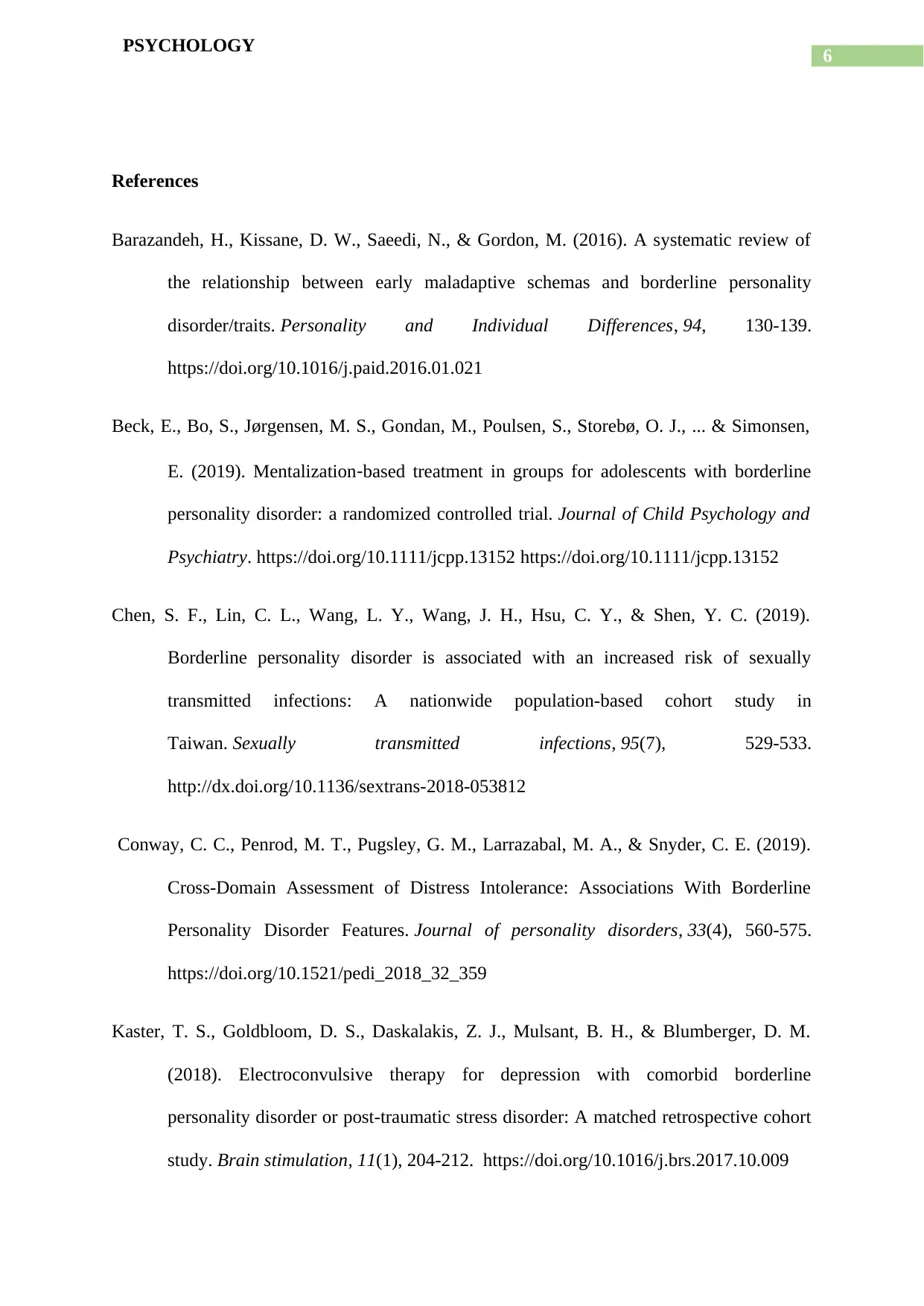
6
PSYCHOLOGY
References
Barazandeh, H., Kissane, D. W., Saeedi, N., & Gordon, M. (2016). A systematic review of
the relationship between early maladaptive schemas and borderline personality
disorder/traits. Personality and Individual Differences, 94, 130-139.
https://doi.org/10.1016/j.paid.2016.01.021
Beck, E., Bo, S., Jørgensen, M. S., Gondan, M., Poulsen, S., Storebø, O. J., ... & Simonsen,
E. (2019). Mentalization‐based treatment in groups for adolescents with borderline
personality disorder: a randomized controlled trial. Journal of Child Psychology and
Psychiatry. https://doi.org/10.1111/jcpp.13152 https://doi.org/10.1111/jcpp.13152
Chen, S. F., Lin, C. L., Wang, L. Y., Wang, J. H., Hsu, C. Y., & Shen, Y. C. (2019).
Borderline personality disorder is associated with an increased risk of sexually
transmitted infections: A nationwide population-based cohort study in
Taiwan. Sexually transmitted infections, 95(7), 529-533.
http://dx.doi.org/10.1136/sextrans-2018-053812
Conway, C. C., Penrod, M. T., Pugsley, G. M., Larrazabal, M. A., & Snyder, C. E. (2019).
Cross-Domain Assessment of Distress Intolerance: Associations With Borderline
Personality Disorder Features. Journal of personality disorders, 33(4), 560-575.
https://doi.org/10.1521/pedi_2018_32_359
Kaster, T. S., Goldbloom, D. S., Daskalakis, Z. J., Mulsant, B. H., & Blumberger, D. M.
(2018). Electroconvulsive therapy for depression with comorbid borderline
personality disorder or post-traumatic stress disorder: A matched retrospective cohort
study. Brain stimulation, 11(1), 204-212. https://doi.org/10.1016/j.brs.2017.10.009
PSYCHOLOGY
References
Barazandeh, H., Kissane, D. W., Saeedi, N., & Gordon, M. (2016). A systematic review of
the relationship between early maladaptive schemas and borderline personality
disorder/traits. Personality and Individual Differences, 94, 130-139.
https://doi.org/10.1016/j.paid.2016.01.021
Beck, E., Bo, S., Jørgensen, M. S., Gondan, M., Poulsen, S., Storebø, O. J., ... & Simonsen,
E. (2019). Mentalization‐based treatment in groups for adolescents with borderline
personality disorder: a randomized controlled trial. Journal of Child Psychology and
Psychiatry. https://doi.org/10.1111/jcpp.13152 https://doi.org/10.1111/jcpp.13152
Chen, S. F., Lin, C. L., Wang, L. Y., Wang, J. H., Hsu, C. Y., & Shen, Y. C. (2019).
Borderline personality disorder is associated with an increased risk of sexually
transmitted infections: A nationwide population-based cohort study in
Taiwan. Sexually transmitted infections, 95(7), 529-533.
http://dx.doi.org/10.1136/sextrans-2018-053812
Conway, C. C., Penrod, M. T., Pugsley, G. M., Larrazabal, M. A., & Snyder, C. E. (2019).
Cross-Domain Assessment of Distress Intolerance: Associations With Borderline
Personality Disorder Features. Journal of personality disorders, 33(4), 560-575.
https://doi.org/10.1521/pedi_2018_32_359
Kaster, T. S., Goldbloom, D. S., Daskalakis, Z. J., Mulsant, B. H., & Blumberger, D. M.
(2018). Electroconvulsive therapy for depression with comorbid borderline
personality disorder or post-traumatic stress disorder: A matched retrospective cohort
study. Brain stimulation, 11(1), 204-212. https://doi.org/10.1016/j.brs.2017.10.009
Paraphrase This Document
Need a fresh take? Get an instant paraphrase of this document with our AI Paraphraser
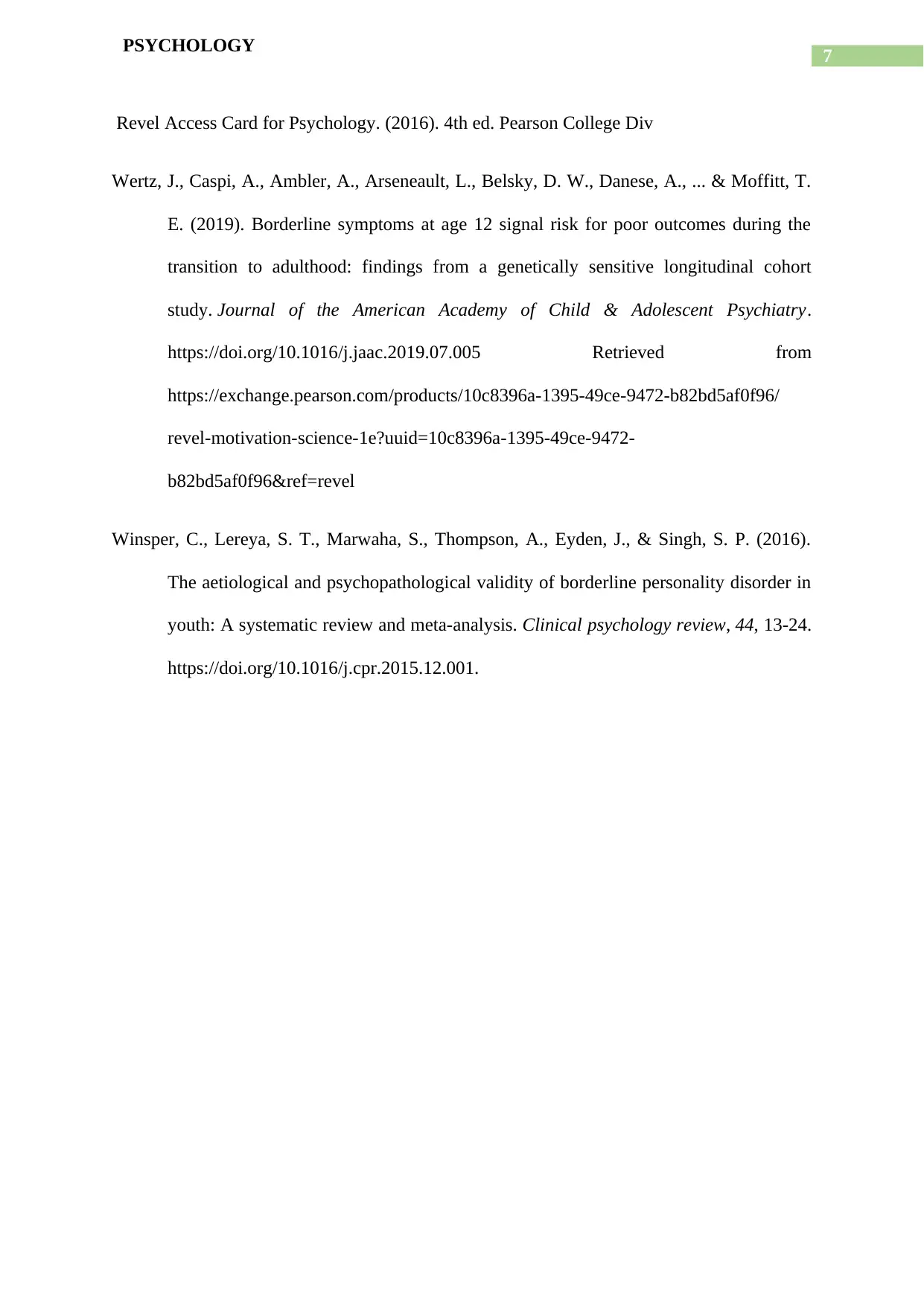
7
PSYCHOLOGY
Revel Access Card for Psychology. (2016). 4th ed. Pearson College Div
Wertz, J., Caspi, A., Ambler, A., Arseneault, L., Belsky, D. W., Danese, A., ... & Moffitt, T.
E. (2019). Borderline symptoms at age 12 signal risk for poor outcomes during the
transition to adulthood: findings from a genetically sensitive longitudinal cohort
study. Journal of the American Academy of Child & Adolescent Psychiatry.
https://doi.org/10.1016/j.jaac.2019.07.005 Retrieved from
https://exchange.pearson.com/products/10c8396a-1395-49ce-9472-b82bd5af0f96/
revel-motivation-science-1e?uuid=10c8396a-1395-49ce-9472-
b82bd5af0f96&ref=revel
Winsper, C., Lereya, S. T., Marwaha, S., Thompson, A., Eyden, J., & Singh, S. P. (2016).
The aetiological and psychopathological validity of borderline personality disorder in
youth: A systematic review and meta-analysis. Clinical psychology review, 44, 13-24.
https://doi.org/10.1016/j.cpr.2015.12.001.
PSYCHOLOGY
Revel Access Card for Psychology. (2016). 4th ed. Pearson College Div
Wertz, J., Caspi, A., Ambler, A., Arseneault, L., Belsky, D. W., Danese, A., ... & Moffitt, T.
E. (2019). Borderline symptoms at age 12 signal risk for poor outcomes during the
transition to adulthood: findings from a genetically sensitive longitudinal cohort
study. Journal of the American Academy of Child & Adolescent Psychiatry.
https://doi.org/10.1016/j.jaac.2019.07.005 Retrieved from
https://exchange.pearson.com/products/10c8396a-1395-49ce-9472-b82bd5af0f96/
revel-motivation-science-1e?uuid=10c8396a-1395-49ce-9472-
b82bd5af0f96&ref=revel
Winsper, C., Lereya, S. T., Marwaha, S., Thompson, A., Eyden, J., & Singh, S. P. (2016).
The aetiological and psychopathological validity of borderline personality disorder in
youth: A systematic review and meta-analysis. Clinical psychology review, 44, 13-24.
https://doi.org/10.1016/j.cpr.2015.12.001.
1 out of 8
Related Documents
Your All-in-One AI-Powered Toolkit for Academic Success.
+13062052269
info@desklib.com
Available 24*7 on WhatsApp / Email
![[object Object]](/_next/static/media/star-bottom.7253800d.svg)
Unlock your academic potential
Copyright © 2020–2025 A2Z Services. All Rights Reserved. Developed and managed by ZUCOL.




